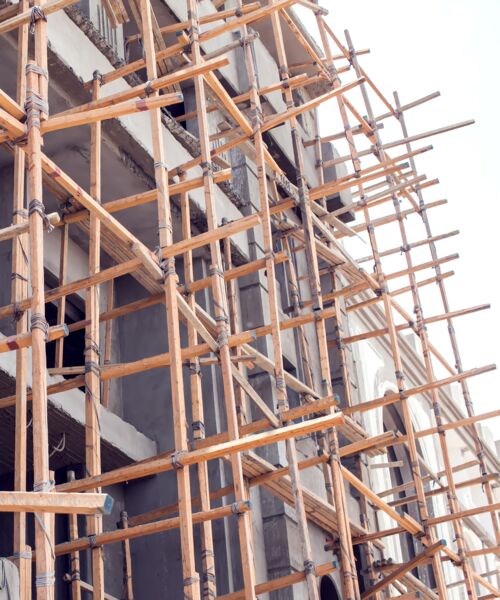Checking Out the Numerous Sorts Of Scaffolding Used in Building Jobs
The building market depends greatly on numerous types of scaffolding to fulfill particular job demands, each offering unique benefits and applications. Traditional framework scaffolding offers a sturdy foundation for general tasks, while suspended scaffolding is essential for job on skyscraper structures.

Conventional Framework Scaffolding
Standard structure scaffolding is one of the most commonly made use of methods in the building sector due to its effectiveness and adaptability. This system includes vertical and horizontal structures that are put together to create a steady platform for materials and workers. The main parts consist of upright messages, horizontal ledgers, and angled dental braces, which together offer a solid framework that can sustain substantial tons.
One of the vital advantages of traditional structure scaffolding is its versatility to numerous building and construction jobs, varying from property buildings to huge business structures. The modular layout permits for easy setting up and disassembly, making it reliable for both lasting and temporary jobs. Furthermore, the system can be customized in elevation and size, fitting various building styles and website conditions.
Security is critical in scaffolding applications, and standard frame systems are furnished with guardrails and toe boards to prevent falls and ensure worker defense. Furthermore, routine examinations and adherence to security regulations are vital in maintaining the integrity of the scaffold. Generally, typical structure scaffolding stays a basic choice in the building market, supplying a reliable platform for labor and enhancing overall job effectiveness

Suspended Scaffolding
Suspended scaffolding offers a distinct solution for building and construction tasks that require access to elevated surfaces, particularly in circumstances where standard frame scaffolding might be not practical. This sort of scaffolding is normally put on hold from the roof or upper levels of a framework, making use of a system of ropes, systems, and pulley-blocks to create a functioning space that can be adapted to various elevations.
One of the main advantages of put on hold scaffolding is its flexibility. It can be conveniently repositioned or decreased to accommodate adjustments in construction demands, making it optimal for jobs such as window installment, façade work, and upkeep on high-rise buildings. In addition, the very little impact of put on hold scaffolding enables much better use ground area in metropolitan settings, where space is typically minimal.
Safety is a critical factor to consider in the use of put on hold scaffolding. Proper rigging and anchoring systems need to be used to guarantee stability and protect against accidents. Operators should additionally be educated in the safe use this devices. On the whole, put on hold scaffolding provides a reliable and efficient service for accessing hard-to-reach locations in numerous building and construction scenarios, improving both productivity and security on website.
System Scaffolding
System scaffolding, often considered a modern service in the scaffolding market, includes pre-engineered components that can be quickly put together and adapted for various construction projects. Scaffolding. This sort of scaffolding is identified by its modular layout, which allows for versatility and efficiency on job websites, suiting different heights and structural needs
Commonly made from high-strength steel or light weight aluminum, system scaffolding uses improved resilience and stability. The parts include vertical blog posts, straight ledgers, and angled dental braces, which interconnect securely, guaranteeing a robust structure. The style frequently incorporates standard fittings, streamlining assembly and disassembly procedures, thereby decreasing labor time and expenses.

Rolling Scaffolding
Rolling scaffolding is a flexible option to typical fixed scaffolding, developed for flexibility and ease of use on building and construction sites. This type of scaffolding consists of a platform sustained by structures with wheels, enabling workers to quickly move it as required. The flexibility attribute considerably improves efficiency, as it reduces downtime connected with putting together and disassembling fixed scaffolding.
Generally constructed from lightweight products such as light weight aluminum or steel, rolling scaffolding uses a strong yet portable service for projects calling for constant repositioning - Scaffolding. It is specifically helpful in jobs such as paint, drywall installment, and electric job, where accessibility to different elevations and areas is necessary
Security is extremely Domestic scaffolding important in rolling scaffolding style, with attributes such as securing wheels to avoid unplanned activity when being used, and guardrails to secure workers from falls. In addition, lots of designs are flexible in height, fitting different project requirements.
Cantilever Scaffolding

The layout of cantilever scaffolding generally involves using brackets or arms anchored to a building or framework, making it possible for the system to expand exterior securely. Safety and security is extremely important; hence, these scaffolds have to be crafted to hold up against numerous lots and ecological problems. Regular evaluation and maintenance are vital to make sure architectural stability and worker safety.
Cantilever scaffolding is preferred for its flexibility and efficient use room, making it a preferred selection in city settings where space restraints prevail. In addition, it promotes less complicated accessibility to high altitudes, eventually adding to the overall efficiency of building and construction jobs. Just like all scaffolding types, appropriate training and adherence to safety criteria are important for workers making use of cantilever scaffolding.
Final Thought
Traditional frame scaffolding supplies security, while suspended scaffolding provides adaptability for raised tasks. System scaffolding helps with fast assembly, and rolling scaffolding enhances flexibility for varying work settings.
Conventional frame scaffolding offers a strong structure for basic jobs, while put on hold scaffolding is important for job on high-rise structures.Rolling scaffolding is a versatile alternative to conventional fixed scaffolding, developed for movement and simplicity of use on construction sites. As with all scaffolding types, proper training and adherence to safety and security criteria are critical for employees making use of cantilever scaffolding.
Typical structure scaffolding supplies stability, while suspended scaffolding offers flexibility for elevated jobs. System scaffolding promotes fast assembly, and rolling scaffolding improves mobility for differing job settings.